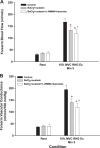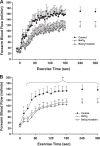KIR channel activation contributes to onset and steady-state exercise hyperemia in humans
- PMID: 24973385
- PMCID: PMC4187399
- DOI: 10.1152/ajpheart.00212.2014
KIR channel activation contributes to onset and steady-state exercise hyperemia in humans
Abstract
We tested the hypothesis that activation of inwardly rectifying potassium (KIR) channels and Na(+)-K(+)-ATPase, two pathways that lead to hyperpolarization of vascular cells, contributes to both the onset and steady-state hyperemic response to exercise. We also determined whether after inhibiting these pathways nitric oxide (NO) and prostaglandins (PGs) are involved in the hyperemic response. Forearm blood flow (FBF; Doppler ultrasound) was determined during rhythmic handgrip exercise at 10% maximal voluntary contraction for 5 min in the following conditions: control [saline; trial 1 (T1)]; with combined inhibition of KIR channels and Na(+)-K(+)-ATPase alone [via barium chloride (BaCl2) and ouabain, respectively; trial 2 (T2)]; and with additional combined nitric oxide synthase (N(G)-monomethyl-l-arginine) and cyclooxygenase inhibition [ketorolac; trial 3 (T3)]. In T2, the total hyperemic responses were attenuated ~50% from control (P < 0.05) at exercise onset, and there was minimal further effect in T3 (protocol 1; n = 11). In protocol 2 (n = 8), steady-state FBF was significantly reduced during T2 vs. T1 (133 ± 15 vs. 167 ± 17 ml/min; Δ from control: -20 ± 3%; P < 0.05) and further reduced during T3 (120 ± 15 ml/min; -29 ± 3%; P < 0.05 vs. T2). In protocol 3 (n = 8), BaCl2 alone reduced FBF during onset (~50%) and steady-state exercise (~30%) as observed in protocols 1 and 2, respectively, and addition of ouabain had no further impact. Our data implicate activation of KIR channels as a novel contributing pathway to exercise hyperemia in humans.
Keywords: blood flow; contraction; skeletal muscle; vasodilation.
Copyright © 2014 the American Physiological Society.
Figures




Similar articles
-
Contracting human skeletal muscle maintains the ability to blunt α1 -adrenergic vasoconstriction during KIR channel and Na(+) /K(+) -ATPase inhibition.J Physiol. 2015 Jun 15;593(12):2735-51. doi: 10.1113/JP270461. Epub 2015 May 20. J Physiol. 2015. PMID: 25893955 Free PMC article. Clinical Trial.
-
Reactive hyperemia occurs via activation of inwardly rectifying potassium channels and Na+/K+-ATPase in humans.Circ Res. 2013 Sep 27;113(8):1023-32. doi: 10.1161/CIRCRESAHA.113.301675. Epub 2013 Aug 12. Circ Res. 2013. PMID: 23940309 Free PMC article.
-
Inhibition of Na+ /K+ -ATPase and KIR channels abolishes hypoxic hyperaemia in resting but not contracting skeletal muscle of humans.J Physiol. 2018 Aug;596(15):3371-3389. doi: 10.1113/JP275913. Epub 2018 Apr 24. J Physiol. 2018. PMID: 29603743 Free PMC article.
-
Sympatholytic effect of intravascular ATP is independent of nitric oxide, prostaglandins, Na+ /K+ -ATPase and KIR channels in humans.J Physiol. 2017 Aug 1;595(15):5175-5190. doi: 10.1113/JP274532. Epub 2017 Jul 9. J Physiol. 2017. PMID: 28590059 Free PMC article.
-
Mechanisms of rapid vasodilation after a brief contraction in human skeletal muscle.Am J Physiol Heart Circ Physiol. 2013 Jul 1;305(1):H29-40. doi: 10.1152/ajpheart.00298.2013. Epub 2013 May 3. Am J Physiol Heart Circ Physiol. 2013. PMID: 23645465 Free PMC article.
Cited by
-
Impairment of Flow-Sensitive Inwardly Rectifying K+ Channels via Disruption of Glycocalyx Mediates Obesity-Induced Endothelial Dysfunction.Arterioscler Thromb Vasc Biol. 2020 Sep;40(9):e240-e255. doi: 10.1161/ATVBAHA.120.314935. Epub 2020 Jul 23. Arterioscler Thromb Vasc Biol. 2020. PMID: 32698687 Free PMC article.
-
Contracting human skeletal muscle maintains the ability to blunt α1 -adrenergic vasoconstriction during KIR channel and Na(+) /K(+) -ATPase inhibition.J Physiol. 2015 Jun 15;593(12):2735-51. doi: 10.1113/JP270461. Epub 2015 May 20. J Physiol. 2015. PMID: 25893955 Free PMC article. Clinical Trial.
-
Sustained exercise hyperemia during prolonged adenosine infusion in humans.Physiol Rep. 2019 Feb;7(4):e14009. doi: 10.14814/phy2.14009. Physiol Rep. 2019. PMID: 30806018 Free PMC article.
-
Potassium Channels in Regulation of Vascular Smooth Muscle Contraction and Growth.Adv Pharmacol. 2017;78:89-144. doi: 10.1016/bs.apha.2016.07.001. Epub 2016 Aug 17. Adv Pharmacol. 2017. PMID: 28212804 Free PMC article. Review.
-
Skeletal muscle contraction-induced vasodilation in the microcirculation.J Exerc Rehabil. 2017 Oct 30;13(5):502-507. doi: 10.12965/jer.1735114.557. eCollection 2017 Oct. J Exerc Rehabil. 2017. PMID: 29114523 Free PMC article. Review.
References
-
- Berdeaux A, Ghaleh B, Dubois-Rande JL, Vigue B, Drieu La Rochelle C, Hittinger L, Giudicelli JF. Role of vascular endothelium in exercise-induced dilation of large epicardial coronary arteries in conscious dogs. Circulation 89: 2799–2808, 1994 - PubMed
Publication types
MeSH terms
Substances
Grants and funding
LinkOut - more resources
Full Text Sources
Other Literature Sources
Medical

